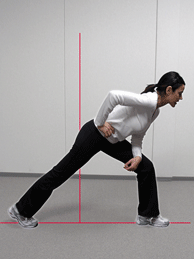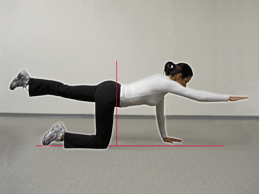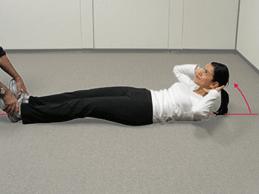Exercises for a Healthy Back - Advanced
On this page
- Why do we need advanced exercises for the back?
- Why do you need to stretch before starting to exercise your back muscles?
- How do you stretch the legs and hips?
- How do you exercise your neck muscles?
- How can you improve fitness and stability in the spine?
- How do you exercise the abdominal muscles?
- Are there any advanced exercises for lateral and oblique abdominal and lumbar muscles?
Why do we need advanced exercises for the back?
Back to topIf done regularly and supplemented by such aerobic activity as walking (see the OSH Answers document Walking - Still Man's Best Medicine), the exercises described in the OSH Answers document Exercises for a Healthy Back should be sufficient to keep your back fit and pain-free. This is, of course, as long as no accident, traumatic injury, or any kind of mishap happens to you.
However, some people may want to enhance their fitness training, either because their jobs include greater physical demands, or simply because they want to push themselves to a higher level of physical conditioning. If this is the case, we suggest that you consult your physician and possibly a fitness expert before you establish your realistic objectives and ways of achieving them.
In this document we will suggest more exercises, not only for the back but also for the hips, knees and neck, based on the concept of "sparing the back", as described by Exercising for a Healthy Back.
The concept of exercising while sparing the back, as well as the exercises included in this document are taken from Low Back Disorder, Evidence-Based Prevention and Rehabilitation (Human Kinetics, 2002) by Stuart McGill, a world-renowned lecturer and expert in spine function and injury prevention and rehabilitation at the University of Waterloo, Ontario.
Why do you need to stretch before starting to exercise your back muscles?
Back to topStretching relaxes your mind and tunes your body. If it is done properly stretching:
- reduces muscle tension;
- promotes cardiorespiratory function;
- improves body awareness;
- multiplies the good effect of the back exercises to follow.
The right way to stretch involves having relaxed, sustained moves with your attention focused on the muscle being stretched. While stretching, avoid bouncing up and down, making jerky movements, or pulling muscles to the point of pain.
How do you stretch the legs and hips?
Back to topStretching
Exercise # 1 -- Stretching the legs
This exercise stretches the muscles of the thighs and lower legs as well as joints such as the hips, knees, and ankles.
The Right Way

Figure 1A
- Lunge with the left leg
- Keep your left foot flat on the ground and the spine perpendicular.
- Keep the back knee flexed.
- Keep the torso upright with the lumbar spine neutral.
- Maintain this position for about 10 seconds, while gently deepening the lunge and maintaining the torso upright.
- Alternate legs and repeat exercise.
The Wrong Way

Figure 1B
Avoid:
- Straightening the back leg.
- Resting your hand on your knee to support the upper body.
- Bending or twisting back.
Exercise # 2 -- Stretching the thighs

Figure 2A

Figure 2B
- Stand beside a solid chair or anything that you can hold onto to maintain your balance.
- Bend your knee on the opposite side and grab the ankle with your other hand.*
- Pull up the ankle trying to touch your buttock on the same side.
- Hold this position for 5 to 10 seconds.
- Gently release your grasp and slowly lower your foot to the ground.
- Do not move the knee throughout the whole stretch.
- Change sides and repeat the exercise with the other leg.
* If you are unable to bend your knee high enough to grab the ankle without bending and twisting your whole body, then use an exercise strap or a strap made out of a belt or scarf -- see Figure 2B. After a few trials you should be able to do it without the exercise strap.
How do you exercise your neck muscles?
Back to topExercises that can improve the endurance of your neck muscles will also make the curl-ups that build endurance in the abdominal muscles easier and more effective.
Exercise # 3 -- Stretching the neck
- Exercises should be done in a sitting position with your feet firmly planted on the floor.
- Do not move neither your head nor neck throughout the whole exercise.
- Place the tongue on the roof of your mouth behind the front teeth.

Figure 3A
- Place your hands on your forehead and push backwards while resisting any motion in the head and neck.
- Hold this isometric position for 5 to 7 seconds, then relax.
- Repeat this exercise up to 5 times.

Figure 3B
- Place your hand on your temple and push sideways while resisting any motion in the head and neck.
- Hold this isometric position for 5 to 7 seconds, then relax.
- Repeat this exercise up to 5 times.
- Change hands and try to push your head to the other side while resisting this motion at the same time.

Figure 3C
- Place your hands on the back of your head and push forwards while resisting any motion in the head and neck.
- Hold this isometric position for 5 to 7 seconds, then relax.
- Repeat this exercise up to 5 times.
How can you improve fitness and stability in the spine?
Back to topThe way to improve and maintain spinal stability is to exercise the spine's major stabilizing muscles:
- Back extensors.
- Abdominal muscles (the so-called "six pack").
- Abdominal muscles (the lateral obliques).
Exercise all these muscles in a special way - by "sparing the back" which means to perform all exercises with the spine in a line with no additional load.
Starting an exercise session
Every session should begin with the "Cat-Camel" exercises -- see Figures 4A, 4B, and 4C.
Exercise # 4 -- "Cat-Camel"

Figure 4A

Figure 4B

Figure 4C
- Start on your hands and knees with your thighs perpendicular to the floor as in Figure 4A.
- Inhale deeply and slowly with the back straight but relaxed as much as possible.
- Exhale and stretch your back by arching it upwards (arching cat position), while remaining relaxed; do not hold your breath as in Figure 4B.
- Inhale deeply and slowly and come back to the starting position, as in Figure 4A.
- Exhale and stretch your back downwards into a swayback (camel) position as in Figure 4C.
- Inhale deeply and slowly and come back to the starting position, as in Figure 4A.
- Repeat the whole sequence 3 to 7 times -- see Figures 4A, 4B, and 4C.
Advanced exercises for the back extensors
Exercise #5 -- The waiter's bow

Figure 5
- Stand straight and relaxed, but not rigid, with head up and shoulders back and relaxed.
- Breathe in and relax, then breathe out, and as you breathe out pull your stomach muscles in.
- While keeping your stomach in, lean forward from the hips at an angle of about 20 degrees and stoop in a position like a "waiters' bow"; keep your back straight for as long as you lean over.
- Hold this bowing position for up to 10 seconds.
- While keeping the stomach in and keeping your back straight, return to the starting position.
- Repeat this sequence up to 10 times.
Exercise #6 -- Advanced Bird-dog
If you have mastered the beginner and intermediate versions of the "bird-dog" exercise illustrated in the OSH Answers document Exercises for a Healthy Back, you can attempt its advanced form.

Figure 6A

Figure 6B

Figure 6C

Figure 6D

Figure 6E
- While on all fours, and without losing your balance, raise your leg by pushing it straight backwards, and raise the opposite arm in front of you, until it is also parallel to the floor and pointing ahead of you.
- Hold this position while slowly exhaling for 2 to 3 seconds -- see Figure 4.
- Inhale while returning your arm and leg to the floor without putting weight on them, then extend them again -- see Figures 6A, 6B, 6C, 6D and 6E.
- Repeat this sequence 5 to 7 times.
- Alternate leg and arm and repeat the whole exercise.
How do you exercise the abdominal muscles?
Back to topExercise # 7 -- Abdominal hollowing
This exercise is fundamental for both conditioning abdominal muscles and for maintaining the stability of the spine.

Figure 7
- Lie on your back with your knees bent.
- Keep your spine in neutral position, neither arched up nor flattened against the floor.
- Inhale deeply and relax your stomach.
- Exhale slowly pulling your lower abdomen inwards toward the floor.
- Continuing regular breathing and hold the tension for 10 seconds.
- Repeat this maneuver up to 10 times.
For a greater challenge try raising your head and shoulders while pulling in your abdominal muscles.
For more variety you can try abdominal hollowing while in a standing or sitting position.
Exercise # 8 -- Curl-up with bent knees

Figure 8
- Lie on your back with your knees bent.
- Keep your spine in neutral position, neither arched up nor flattened against the floor.
- Inhale deeply and relax your stomach.
- Exhale slowly pulling your lower abdomen inwards toward the floor.
- Continuing regular breathing and hold the tension for 10 seconds while raising the head and shoulders -- try to raise your head without bending the neck.
- Repeat this maneuver up to 10 times.
Exercise # 9 -- Curl-up with straight knees

Figure 9
This exercise is just a version of exercise #8 to be performed at your discretion, instead of or in addition to exercise #8.
Curl-ups on unstable surfaces such as a fitness ball or balance disk
Advisory!
- Since exercising on unstable surfaces, especially on a gym ball, involves an increased risk of falling and potential injury, we recommend that you practice them with the assistance of a spotter or exercise partner who can better ensure your safety.
- Curl-ups on unstable surfaces require substantially greater effort and are recommended only for people of above-average fitness.
Exercise # 10 -- Curl-ups on a balance disk

Figure 10
Since exercising while supporting your upper body on a gym ball or a balance disk does not give you the opportunity to rest your head on the floor it is critical to make an extra effort to keep your spine level -- do not allow your head to drop below an imaginary horizontal line at any time during these exercises.
Exercise # 11 -- Curl-ups on a gym ball I

Figure 11A

Figure 11B
- Starting position -- see Figure 11A
- From the starting position raise your head and shoulders without bending the neck -- see Figure 11B.
Exercise # 12 -- Curl-ups on a gym ball II

Figure 12A

Figure 12B
- Starting position -- see Figure 12A.
- From the starting position raise your head and shoulders without bending the neck -- see Figure 12B.
Are there any advanced exercises for lateral and oblique abdominal and lumbar muscles?
Back to topExercise # 13 -- Side-bridge advanced

Figure 13A

Figure 13B

Figure 13C

Figure 13D
- Starting position -- see Figure 13A.
- From the starting position roll over on your elbows -- see Figures 13B, 13C -- until you acquire a position that is the mirror image of the starting one -- see Figure 13D.
- Fact sheet confirmed current: 2016-01-08
- Fact sheet last revised: 2006-07-07
